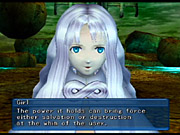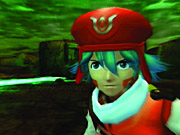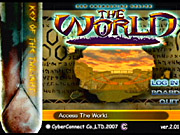.hack infection part 1 Preview
We take a look at Bandai's upcoming offline "online" RPG.
It's been quite some time since the console RPG genre saw a truly unique addition to its static landscape. The impact of seminal games such as Nintendo's The Legend of Zelda and Square's Final Fantasy series have helped shape how the genre has developed on consoles. Unfortunately, the shadow cast by such high-profile titles and their commercial popularity has often resulted in new entries to the genre sticking close to the standard RPG formula. While the approach has yielded some strong titles, the lack of risk taking has kept fresh surprises few and far between. Fortunately, Bandai's upcoming RPG for the PlayStation 2, .hack (pronounced "dot hack") infection part 1, looks as though it will offer a welcome surprise, thanks to its fresh approach to storytelling and game design. We had a chance to check out a preview build of the game to see how this unique title is shaping up.

For those unfamiliar with the game's background, .hack infection part 1 on the PlayStation 2 is one part of a larger multimedia narrative that's made up of .hack anime and manga. Each of the parts tells a different facet of an overarching story that is set in the near future and revolves around a computer virus and an online game called The World. At its core, the .hack concept focuses on this game within a game, which is structured similarly to massively multiplayer PC games like EverQuest or Asheron's Call. The World is having a harmful effect on those who play it because of a computer virus that has infected the game's virtual world. The PlayStation 2 game puts you in the role of a player who begins to search for clues when events in The World affect one of your friends outside of the game. Your quest for information forms the main thrust of the game, which is intended to be the first entry in a four-story saga that will span a series of games that are currently scheduled to ship three to four months apart. Although it may sound as though the complex story will require you to be familiar with the anime and manga, don't worry too much. Each of the different parts is said to be strong enough to stand on its own.
As a result of the rich story, .hack's gameplay is broken up into two levels: the "real" world and the game within a game, The World. The real world component of the game is a simple representation of a typical computer desktop, complete with six icons: mailer, news, accessory, audio, data, and The World. The mailer icon takes you to your e-mail inbox, which holds e-mail from characters you meet and exchange addresses with, as well as cryptic messages from mysterious characters you encounter. The news icon takes you to the in-game equivalent of an Internet news page that features a random sampling of news. Accessory actually lets you change the wallpaper on your desktop screen, while audio lets you do the same with your sound scheme. The data option lets you save your progress. Finally, The World icon is essentially a shortcut to The World game. Selecting it will start the program and take you to a title screen, complete with copyright info that is reminiscent of a PC MMORPG. You'll find three options here: log in, board, or quit. Logging in will put you in the game's virtual world and let you play the game. The board option lets you read a forum dedicated to the game, letting you interact with other "players." This feature is basically a re-creation of a standard Internet message board. The board also serves as a slick way to pass along vital information to you about gameplay and story elements. If you select the quit option, you'll be kicked back to the desktop interface.

When you've logged into The World, you'll find that the gameplay makes a sharp departure from the menu-driven system of the game's real world, as the game will switch to a traditional third-person perspective. When playing in The World, you'll find that the game draws liberally from console and PC RPGs to create a very distinctive experience for a console game. You'll be able to do pretty much everything you'd expect to do, such as explore various worlds, battle enemies, level up, buy better weapons and armor, gather a party, and interact with other characters in the guise of your online persona, Kite. However, the game's story and its solid helping of plot twists and mystery keep you from getting too comfortable. While there will obviously be scripted points in the game that drive the main story, .hack's design does an impressive job of ensuring that you don't feel constrained. For example, there are various servers in the game that house different areas to explore, and you'll access those areas by using a gate system that warps you to them. The system works via a keyword system that requires you to enter three words in order to access different areas. While you'll start with a default list of words, and you'll gain more and learn about specific plot-related areas by checking e-mail or visiting the forums. However, once you learn how the keyword system works, you can actually cobble together your own combinations and explore on your own. Granted, your exploration may be seriously hampered if you accidentally warp into an area crawling with high-level enemies, but it's still nice to see that bit of freedom included.
Who's Playing Who?
Another cool feature is the game's party system, which lets you ask players you've exchanged addresses with in the game to form a party with you. Combat in the game plays out in real time, although you'll be able to pause it to access menus that let you give orders to your party, perform special attacks, or use various items. Over the course of your investigation into your friend's condition and its tie to the game, you'll gain the ability to "hack" into The World. So far, we've seen the data drain ability and gate hacking. Data drain lets you rewrite an enemy character's data once you've weakened it enough. Not only does the shady tactic convert your foe into a less harmful form, but it will also reward you with items. The catch to this ability is that it's tied to the virus infecting the game, and if you use it too often, you can expect some unpleasant side effects. Gate hacking lets you use items to hack into blocked warp gates and access new areas.

Despite its complex story and dual gameplay types, .hack is actually quite user-friendly. You're introduced to the game's accessible control scheme the first time you log in to The World by your soon-to-be-incapacitated friend, who's a veteran player. You'll have a single attack button that will let you brawl with enemies that are within your range, and you'll also be able to use special skills that you'll gain by equipping different weapons or the aforementioned data drain technique. You'll navigate through the different environments via an onscreen map, and you will deal with assorted foes that pop out of warps around you.
Graphically, .hack sports a stylized look that looks quite sharp on the PlayStation 2. The game's graphics are detailed and showcase the game's manga-influenced art style to good effect. The characters all sport a consistent look that fits the archetypes they're meant to represent in the game. The environments feature distinctive looks that represent the various elements they're based on--barren deserts for fire, for example. The town we saw featured European-influenced architecture and a good amount of detail that extended all the way down to the cobblestone textures on the ground. We have to say we were especially impressed with all the little details that have been used in the town to sell you on the experience that you're actually playing on online game. You'll see other players running around with chat bubbles around their heads, and they'll be interacting with others as you make your way through town, visiting the various shops. The special effects used for attacks such as the data drain are nicely done and feature some nice color usage.

The game's audio is well done too, offering a solid mix of ambient sound and tunes that help set the tone for the areas you'll find yourself in. The voice acting is actually pretty decent in English, which is nice to see, but we're happy that you'll actually have the option to toggle subtitles and Japanese speech on as well.
Judging from what we've played so far, .hack is shaping up to be a cool title that brings a fresh and promising perspective to the common RPG. The game's unique approach to storytelling and its "game within a game" element are done extremely well and are very appealing. The little touches such as the NPCs roaming around town and the e-mail and forum postings that will appear as you play the game are very effective at selling the whole game experience. Anyone looking for a cool change of pace from traditional RPGs will want to keep an eye out for .hack infection part 1 when it ships early next year. Look for more on the game and the ensuing installments in the series in the coming months.
Got a news tip or want to contact us directly? Email news@gamespot.com
Join the conversation